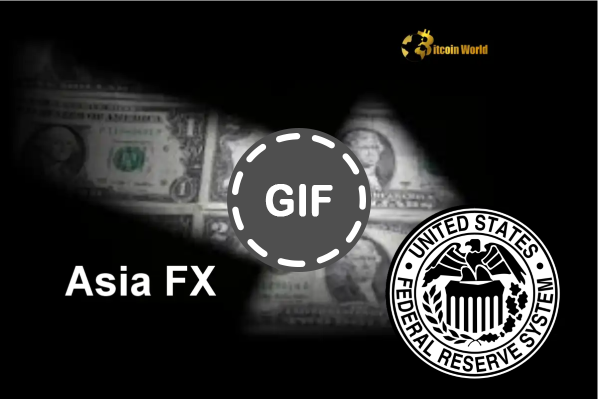BitcoinWorld

Asia FX Surges: Dollar Retreats Amid Trade Hopes and Fed Cut Bets
In the dynamic world of global finance, shifts in major currency pairs often signal broader economic trends. For those tracking digital assets and the wider investment landscape, understanding movements in the Forex market is crucial. Recently, we’ve seen significant momentum building in Asia FX, with several regional currencies strengthening against the US Dollar. This isn’t happening in a vacuum; it’s a direct response to evolving macro-economic factors, primarily progress in US-China trade discussions and growing expectations around Fed rate cuts.
Why is Asia FX Strengthening?
Asian currencies are experiencing tailwinds from multiple directions. A primary driver is the easing tension in US-China trade relations. As the two economic giants show signs of reaching agreements, it reduces uncertainty for Asian economies heavily reliant on trade with both nations. This improved outlook enhances investor confidence in the region, leading to increased capital flows and stronger local currencies.
Additionally, many Asian economies are demonstrating resilience and steady growth, making their currencies attractive relative to others perceived as facing headwinds. The carry trade, where investors borrow in low-interest-rate currencies and invest in higher-yielding ones, also plays a role, favoring certain Asian currencies as interest rate differentials shift.
The Retreat of the US Dollar
The other side of the coin is the weakening US Dollar. The greenback’s value is influenced by numerous factors, but currently, two stand out:
- Trade Progress: As US-China trade tensions appear to soften, the ‘safe-haven’ demand for the dollar tends to diminish. In times of global uncertainty, investors often flock to the perceived safety of the US dollar, US Treasuries, and gold. When risks subside, capital flows back into riskier assets and currencies, weakening the dollar.
- Fed Rate Cut Expectations: Market sentiment is increasingly pricing in potential interest rate cuts by the U.S. Federal Reserve. Lower interest rates generally make a country’s currency less attractive to foreign investors seeking yield. If the Fed cuts rates while other central banks hold steady or even hike, the interest rate differential narrows, reducing the appeal of dollar-denominated assets and weakening the dollar.
Understanding Fed Rate Cuts and Their Impact
The Federal Reserve’s monetary policy decisions are arguably the single biggest driver of US Dollar strength or weakness. When the Fed signals or implements interest rate hikes, it typically strengthens the dollar by increasing the return on dollar-denominated investments. Conversely, when the Fed signals or implements rate cuts, it tends to weaken the dollar.
Current market expectations for Fed rate cuts stem from various economic indicators, including inflation data, employment figures, and overall economic growth projections. If inflation appears under control and growth shows signs of slowing, the Fed might opt for cuts to stimulate the economy. These expectations are closely watched by traders globally and have a direct impact on the Forex market.
Here’s a simplified look at the potential chain reaction:
Fed Signals Rate Cuts → Lower Expected USD Yields → Reduced Demand for USD → US Dollar Weakens → Other Currencies (like Asia FX) Strengthen Relative to USD.
The Influence of US-China Trade Progress
Trade relations between the United States and China have a profound impact on global markets, particularly the Forex market and currencies of trade-dependent nations. When trade tensions escalate, it disrupts supply chains, imposes tariffs, and creates economic uncertainty, often leading to:
- Increased demand for safe-haven assets (strengthening USD).
- Weakening of currencies tied to trade (many Asia FX currencies).
- Reduced global trade volume.
Conversely, progress or de-escalation in US-China trade talks has the opposite effect:
- Reduced demand for safe-havens (weakening USD).
- Strengthening of trade-sensitive currencies (benefiting Asia FX).
- Improved economic outlook for trade-reliant regions.
Recent positive signals regarding trade discussions are a key factor underpinning the current strength observed in Asian currencies.
Navigating the Broader Forex Market Landscape
These major shifts involving the US Dollar, Asia FX, Fed rate cuts, and US-China trade are central to understanding the current global financial environment. For traders and investors, particularly those in volatile markets like cryptocurrency, paying attention to these macro signals is vital. While crypto markets have their own unique drivers, they are not immune to global liquidity conditions and risk sentiment, both heavily influenced by central bank policies and geopolitical stability.
Key Observations:
- Increased Volatility: Periods of shifting expectations around Fed policy or trade outcomes often lead to increased volatility in currency pairs.
- Opportunity: For Forex traders, these shifts present potential trading opportunities in various currency pairs (e.g., USD/JPY, AUD/USD, USD/CNY).
- Risk: Unexpected reversals in trade talks or Fed communication pose significant risks.
Actionable Insights for Investors
What does this mean for you? While this article focuses on the Forex market, the implications extend to other asset classes:
- Stay Informed: Keep a close watch on official statements from the Federal Reserve and developments in US-China relations.
- Understand Correlation: Recognize that while not perfectly correlated, a weaker US Dollar can sometimes coincide with increased investor appetite for riskier assets, including certain cryptocurrencies.
- Risk Management: Global macro uncertainty remains. Ensure your investment strategies account for potential sudden shifts in market sentiment.
- Diversification: Consider how global currency movements might impact internationally diversified portfolios.
The current trend of Asia FX gains and US Dollar weakness, fueled by hopes of Fed rate cuts and positive signs in US-China trade, paints a picture of shifting global dynamics. These movements are not just abstract economic indicators; they influence the cost of goods, international investment flows, and market sentiment across various asset classes, including the increasingly interconnected world of digital currencies.
To learn more about the latest Forex market trends, explore our article on key developments shaping US Dollar liquidity.
This post Asia FX Surges: Dollar Retreats Amid Trade Hopes and Fed Cut Bets first appeared on BitcoinWorld and is written by Editorial Team





